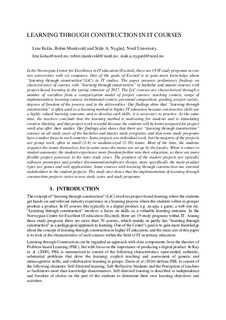| dc.description.abstract | In the Norwegian Center for Excellence in IT education (Excited), there are 19 IT study programs across two universities with six campuses. One of the goals of Excited is to gain more knowledge about “learning through construction”(LtC) in IT studies. The paper presents preliminary findings on characteristics of courses with “learning through construction” in bachelor and master courses with project-based learning in the spring semester of 2017. The LtC courses are characterized through a number of variables from a categorization model of project courses: teaching context, range of implementation, learning context, institutional context, personnel composition, grading, project variety, degrees of freedom of the process and in the deliverables. Our findings show that “learning through construction” is often used as a learning method in higher IT education because constructive skills are a highly valued learning outcome, and to develop such skills, it is necessary to practice. At the same time, the teachers conclude that the learning method is motivating for students and is stimulating creative thinking, and that project work is useful because the students will be better prepared for project work also after their studies. Our findings also shows that there are “learning through construction” courses on all study years of the bachelor and master study programs, and that some study programs have a maker focus in each semester. Some projects are individual work, but the majority of the projects are group work, often in small (2-4) or medium-sized (5-10) teams. Most of the time, the students organize the teams themselves, but in some cases the teams are set up by the faculty. When it comes to student autonomy, the students experience more freedom further into their education, as there are more flexible project processes in the later study years. The products of the student projects are typically software prototypes and product documentation/software design, more specifically the main product types are games and web applications. Some courses with learning through construction use external stakeholders in the student projects. The study also shows that the implementation of learning through construction projects varies across study years and study programs. | nb_NO |
